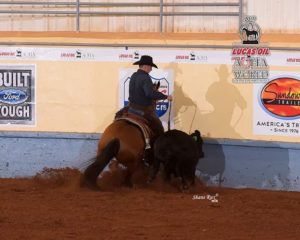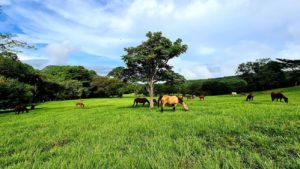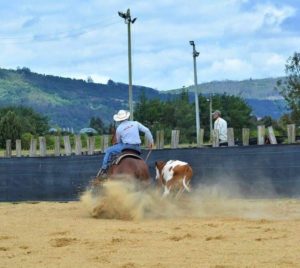
ACRICAMDE President Carlos Rodriguez turning the cow at the AQHA World show in 2019. Photo by Shane Rux Photography
White, sandy beaches, tropical jungles and exotic wildlife spring to mind at the mention of Costa Rica. But it may surprise you to know this popular tourist destination is home to a budding cow horse community.
The performance horse industry in Costa Rica is recognized by the AQHA as an affiliate through the organization Asociación de Criadores de Caballo de Campo y Deportivo (ACRICAMDE). The Association offers most western disciplines and has approximately 500 members; about 20 of them are cutters and seven of them compete in cow horses.
ACRICAMDE president Carlos Rodriguez is a full time trainer with a barn of over 25 horses ranging in disciplines. He has traveled back and forth to the United States for a few years first in 2005 to expand on his knowledge and learn from Jay McLaughlin.
“I became a professional horseman two years ago and that helped me to learn how important it is to help other people at the shows. They don’t know the rules or patterns so that’s what I’ve been doing most of the time,” Rodriguez said.
In 2019 Rodriguez competed in the United States at the AQHA World show on a borrowed horse. It was a great experience and he hopes to do it again one day.
One of Rodriguez’s students is Jose Cedeño. At 15 years old, Cedeño started training horses and participating in clinics. At 17 he went to his first AQHA Youth World Show in the United States on a borrowed horse and got 10th place qualifying him for the NRCHA Celebration of Champions Youth boxing class in 2018.He has traveled back and forth between the United States and Costa Rica for a few years and in 2019 he competed in his last youth show.
Like most Costa Ricans, Cedeño works in all disciplines but the cow horse is his favorite. A year and half ago he was able to get the opportunity to ride better horses in Columbia but he is moving back to Costa Rica soon.

The performance horse industry in Costa Rica is recognized by the AQHA as an affiliate through the organization Asociación de Criadores de Caballo de Campo y Deportivo (ACRICAMDE). The Association offers most western disciplines and has approximately 500 members; about seven of them are cow horse competitors.
“Cow horse is amazing. It’s so complete and you have to make such a super horse to do the three events. As a trainer and as a showman it’s really thrilling. You don’t get [the feeling] in any other event. There’s no discipline that compares to the cow horse,” Cedeño said.
As far as the differences between the States and Costa Rica, Cedeño said the main one is horsepower. They are working on breeding better horses but the biggest difference is the cows. In the States most cow horse competitors work Angus, in Costa Rica they work Brahmas that have a wilder temperament and a big working bubble. There will be no petting the cow as you circle up on a Brahma.
“When you do circles [in the cow work] you can’t get close to the cow. It’s not possible with the cows we use. I think that’s the biggest difference,” Cedeño said. Rodriguez said they, fortunately, have no problems finding cattle.
“We can find cattle anywhere!…Everyone has cows and they’re willing to give us cows,” Rodriguez said.
Cedeño said he has found that some cattle ranchers are extra careful about loaning their cattle out because they don’t want the weight run off of them but they do like to loan the cattle to cow horse competitors.
In Costa Rica, riders regularly ship semen over to breed their mares with top US cutting horse stallions such as Smooth Talkin Style, High Brow Cat and Kit Kat Sugar. They also have mares bred to Bet Hesa Cat, Boon Too Suen and Rockin W currently.
To show a cow horse it costs $50, the ultimate prize is the honor of winning the year end buckle in either the Amateur or Open class. There are about 7-10 entries in the cow horses classes and five shows per year. They run the cow horse classes using the AQHA format of reining and cow work only. The shows usually last two days so they do cutting, reining and then the cow horse events. They have the Open and Amateur classes and the rider can decide what bit or bridle set up they show in. Competitors also have the option to box or go down the fence.
They are hoping to continue to grow the sport but it is such a specialized industry that it is not attainable for everyone.
The fledgling industry’s biggest challenge is finding judges. They used to have five AQHA judges but they chose not to keep up with the qualification. They currently use judges from Costa Rica who aren’t riders or AQHA approved. One option is to fly judges in from another country but that is expensive and unsustainable.

“… As a trainer and as a showman [cow horse is] really thrilling. You don’t get [the feeling] in any other event. There’s no discipline that compares to the cow horse,” Cedeño said.
Rodriguez said, “We have been trying to do cutting, cow horse, reining and ranch riding so we can use the judge for different things so you can get more entries and pay the judge.” This became difficult for any one judge to be expert enough in all disciplines.
“We have to learn to deal with that. It takes a lot of patience and a lot of everything. We have to do clinics with ourselves and practice and try to teach our help… It’s hard but we are growing and we have to do it.”
“We have a lot of arenas here. Most of them are outdoors but we have some indoors. We have no problems with facilities,” he added.
Rodriguez rides a Gunners Special Nite out of a Smart Chic Olena mare and he is working on his roping hoping to compete at the World’s Greatest Horseman in Fort Worth, TX one day.
Cedeño’s goal is to come to the United States to train, compete and immerse himself in the sport.
Brought to you by Dual Smart Rey
